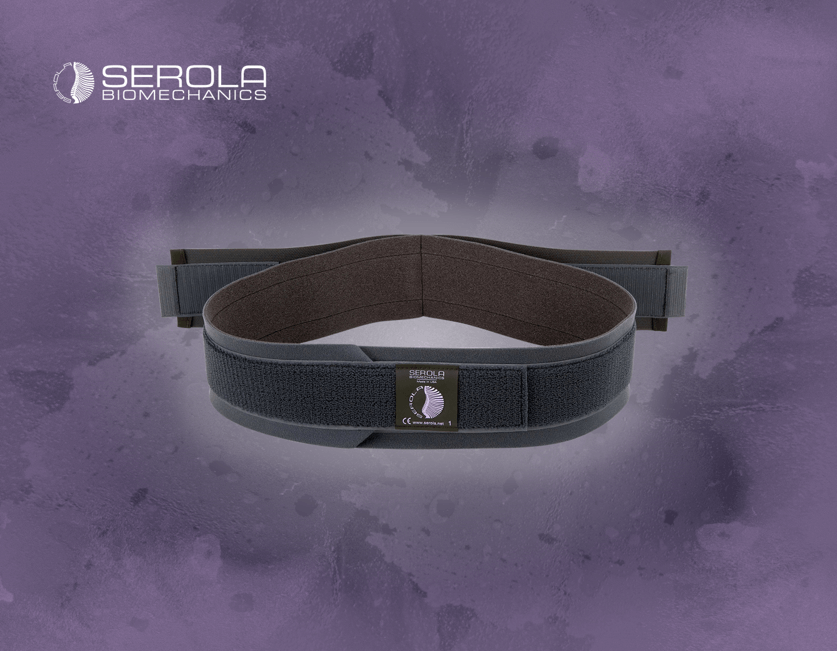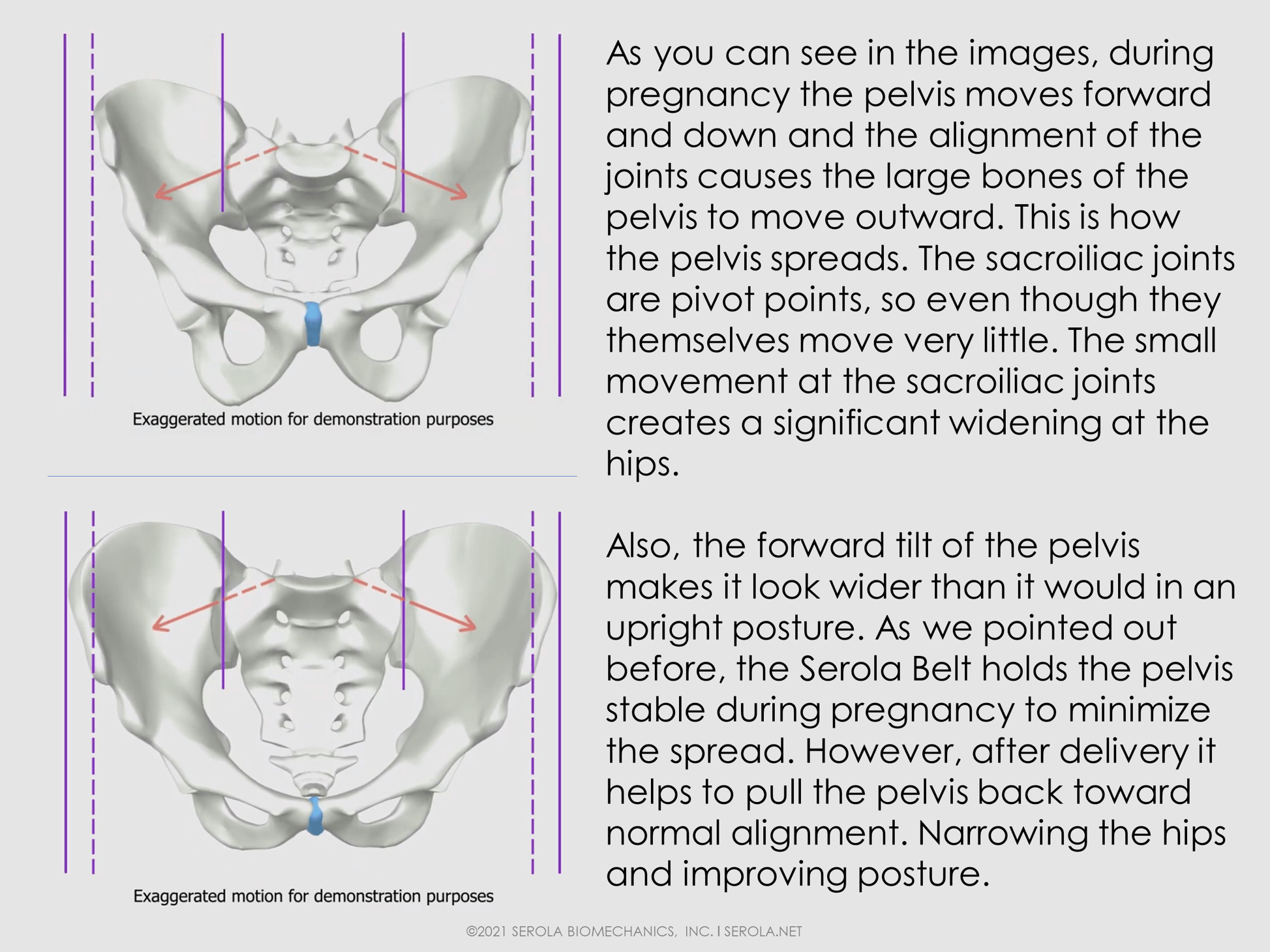The Serola Difference in Sacroiliac Belts

Understanding a problem may do little good if you can’t do anything about it. For this reason, I am taking the helpful step of writing an informational blog that explains the biomechanics behind the development of the Serola Belt.
The primary purpose of a sacroiliac belt (aka pelvic belt or trochanteric belt) is to keep stress off the ligaments within the joint; it does this by keeping the SIJ within normal range of motion (ROM). The more the sacroiliac joint (SIJ) is kept within normal ROM, the less stress is put on the ligaments, the less the muscles tighten, and less pain is experienced.
The SIJ is not only the largest joint in our bodies, it’s also our core structure; it is the center of movement and plays a regulatory role in the synchronization of forces between the upper and lower body. Because our structure is a series of interconnected bones, muscles, and fascia, any movement occurring in one part is reflected in all parts, but particularly in the SIJ. Because of its central role, a small nod at the core translates to moderate movement in the trunk, and large gestures at the extremities. To handle all the stress from transferring force streams throughout the body, our core is held together by the largest and strongest group of ligaments in the body.
But, like any joint, it is subject to injury, in which the ligaments sprain (tear). The short strong Interosseous ligaments deep within the joint do not tear in the middle; instead, they pull away from the joint surfaces, so the joint separates slightly. When any space opens in the body, even microscopically, fluid fills the newly created space. This fluid creates pressure within the joint as it pushes out on the joint surfaces, which stretches the sprained ligaments and sets up a counterreaction. Within the SIJ, a ligamento-muscular (LM) reflex is initiated which causes the muscles to contract in an attempt to keep stress off the ligaments. The balance between the internal pressure of the fluid pushing outward and the external pressure of the muscles pulling inward creates stability, as well as the body can do on its own.
Due to injury, the ligaments are torn and weak and cannot maintain the joint within normal ROM, so they stimulate the muscles to help. The greater the sprain, the tighter the muscles. Each time the joint goes beyond normal range of motion, additional stress is put on the ligaments, so they direct the muscles to tighten further. Tight muscles produce pain.
Two concepts in sacroiliac belts, elastic and non-elastic
A non-elastic belt is meant to provide a stop point at the normal end of its ROM. Like ligaments, it is not meant to compress but, if made right, it will keep stress off the ligaments by limiting motion to remain within its normal range; this is the most important function of an SI belt. The key is to put the belt on tight enough to compress the soft tissue of the pelvis to establish a stop point at the normal end of ROM. Too tight and it may compress the vessels within the ligamentous portion of the SIJ and cause other problems, including increased weakness, reduced joint motion, and pain. Too loose and it may allow the joint to open enough to stress the ligaments during certain movements, and prevent healing. Once normal ROM is exceeded, the ligaments continue to tear and cause reactive muscle tension and pain. Because it is important, I am emphasizing this point; put the first (non-elastic) layer of the Serola Sacroiliac Belt on about as tight as you can so it prevents excess motion. There is no buckle because using one gives too much leverage and can lead to overtightening and more dysfunction and pain.
Proper SI belt tightness is different for each individual due to varying amounts of soft tissue on one’s pelvis. A very thin person will not need the belt to be tightened as much as a heavy person because they don’t have as much soft tissue to compress. The ideal tightness is about what one would use to tie shoestrings.
An elastic sacroiliac belt compresses the sacroiliac joint (SIJ). When stretched by body movements, it has the resilience to adapt to the movement and spring back to continue compression. Although elastic does help limit ROM, it primarily helps takes pressure off the ligaments by bringing the sacral and iliac surfaces closer together, and pushing fluid out of the joint. Because the elastic effects feel good, some people mistakenly think that this is enough. But the problem is that elastic cannot create a stop point at the end of ROM, so the ligaments are repeatedly stressed during certain movements, and the SI ligaments cannot heal.
The Serola Difference: Combining both elastic and non-elastic in sacroiliac belts. The elastic layer enhances stability by providing compression and resilience, but within the range of motion established by the non-elastic layer. More specifically, the non-elastic layer prevents excess movement from detaching the ligaments from their sacral and iliac surfaces while the elastic layer helps compress the joint and assist the bands of the interosseous ligaments to re-integrate into the joint surfaces. In this manner, the non-elastic layer prevents further injury, while the elastic layer helps calm and heal the SI joint.
Front to Back Pull of the Elastic
Additionally, the front-to-back pull of the elastic brings the pelvis back toward neutral stance so that one is standing straighter and taller, opening the lumbosacral area and minimizing stress on the vertebrae, discs, facets, and nerve roots. Together, the two layers normalize the motion and, thereby, the function of the sacroiliac joint.
As in any injured joint, the muscles will pull the structure away from injury. The structural compensation to the nutation lesion is counternutation, so we see them come into the office with anterior pelvic tilt as part of the counternutation complex. As a result, the person suffers more from the compensation than from the original injury. Therefore, it is necessary to pull the pelvis back toward nutation (posterior pelvic tilt) without going too far into nutation to reinjure the SIJ; this is what the Serola Sacroiliac Belt is designed to do.
Sometimes, false testing results will indicate that the pelvis should be pulled forward to further anterior pelvic tilt. Unfortunately, in addition to worsening anterior pelvic tilt, a back to front pull will increase compression at the lumbosacral area and may lead to other dysfunctions listed above. Fortunately, these tests will clear later and the benefit of a front to back pull will be evident.
Increased Strength
Hilton’s Law infers that the muscles that attach to the bones that make up any joint are regulated by the ligaments within the joint. The SIJ is made up of the bones of the pelvis. Therefore, all the muscles that attach to the pelvis are involved in its movement.
In an SIJ ligament injury, since most of the muscles from the head to the knees attach to the pelvis, they are either activated (tightened) or inhibited (loosened) in an attempt to help stabilize the SIJ and keep stress off of the ligaments. Both sets of muscles are functionally weaker. If an SI Belt is too tight or too loose, the SIJ becomes imbalanced, and the muscles compensate. Although the Serola Sacroiliac Belt is not meant to reinforce specific muscles, overall muscle strength and function can be restored close to normal throughout the body. Tight muscles relax and can use their power more efficiently, and inhibited muscles increase tone and, thereby, strength. The muscles that affect our core structure become balanced, less painful, and more efficient.
Unfortunately, lumbar supports, including industrial belts and belly bands, take an entirely different approach. Instead of supporting the joints, they support the muscles. Because the muscles no longer have to work, over time, they atrophy and weaken.
As discussed earlier, even a sacroiliac belt can be detrimental if too tight or too loose. The Serola Sacroiliac Belt’s focus is to compress and support the joint with the correct amount of compression. Keeping the SIJ within normal range of motion allows the muscles to function normally. No further support to the muscles is needed, or recommended.
Non-Slip
Another important function of the Serola Belt deals with the natural curvature of the pelvis, narrower above and wider below, especially with women. This curve often causes most SI belts to slip upwards toward the waist. If it slips up onto the anterior superior iliac spine (ASIS – the bumps at the front sides of the pelvis) the pressure on the upper pelvis may cause the lower pelvis to flare outward, and place stress on the lower SIJ ligaments. The patented secure gripping characteristics of the non-slip inner layer of the Serola Sacroiliac Belt keeps it in place better than any other belt available, a subtle but important feature.
Durability
Elastic Component: An important factor in durability is the quality of material and the quality of the manufacturing process. The Serola Sacroiliac Belt is made with woven instead of knitted elastic. Woven elastic is made of many long thin rubber bands, wrapped in polyester, that traverse the length; it is generally used for heavyweight fabrics. You can expect a proportionate wear pattern with the elastic layer to that of rubber bands.
Knitted elastic, on the other hand, is made of one strand that is looped continuously; it is used for lightweight and medium weight fabrics. Knitted elastic looks good at first, but wears out in
weeks. Woven elastic is much stronger, much more durable, and made for heavyweight fabrics; it keeps its resilience and lasts much longer.
Non-elastic component: The part of the non-elastic layer that determines its useful time period is the hook and loop. In both low and high pile loop (ours is high pile), there are a lot of cheap low quality products on the market that cannot be distinguished by simply looking at them; you find out when it falls apart. The Serola Sacroiliac Belt uses only the highest quality hook and loop for maximum usage.
Consistency
Because of the construction method, woven elastic is difficult to make consistently; this is why we take great care during the manufacturing process. Each component of the Serola Belt is made to exacting standards and they are followed rigorously.
We continuously inspect each roll of elastic for consistent stretch, to ensure that the elastic does not go too far, or not far enough, around the wearer’s hips; to do this, we manually stretch a section at the beginning, middle, and end of each fifty yard roll.
And the stretch of each strand of rubber must be consistent at the top and bottom of the elastic band, or the elastic will curve. In addition to the elastic, the sizing (starch) that gives the elastic band its body must be consistently applied, or one belt may be harder to pull than another.
Each and every Serola Sacroiliac Belt is inspected by hand before it leaves our shop, here in the USA.
Extender
The Serola Sacroiliac Belt Extender is the perfect solution for pregnant women who, due to the growing baby, find that their Serola Sacroiliac Belt no longer fits. In the later stages of pregnancy, the symphysis pubis may become tender and painful; this is the time to wear the belt in the lower position, directly on the trochanters, which are usually considerably wider than the upper position. In these situations, instead of buying a larger belt, you can get a Serola Sacroiliac Belt Extender, which gives an extra 8 inches. Later, after delivery, you can discard the extender after you have returned to a smaller size.
Because hook and loop differs between manufacturers, an Extender from Serola will not work well with other sacroiliac belts. When the hook and loop are different, you will find that they disengage much easier.
Shrinks Hips – a Misnomer
Lumbar and belly band type belts only work where you put them, on the belly. But, instead of tightening up the belly muscles, they actually promote flaccidity. Fortunately, once the baby is delivered, the belly and hips naturally tend to tighten on their own. Unfortunately, marketers attribute this natural shrinkage to use of belly bands (lumbar belts), when the only demonstrable result of such belts is weakness and instability. You can’t push a muscle into shape.
Rather than shrinking the hips, we should look at the effect of pregnancy on our core structure, the sacroiliac joint. During pregnancy, the sacroiliac joint acts as a pivot point wherein the sacrum and ilia separate slightly, but the pelvis widens significantly to prepare the hips for delivery of the baby. Occasionally, the sacroiliac joints may misalign as they loosen. Bringing the sacrum and ilia back into proper alignment includes inducing rotation and compression; usually, these movements are handled by the muscles.
 However, sometimes, the hips need a little assistance; this is where the two layers of the Serola Sacroiliac Belt are helpful. The elastic layer applies a constant pressure to tighten the pelvis. As the pelvis narrows, the non-elastic layer is used to help hold the reduced size. Together, they work the pelvis to narrow – hold – narrow – hold, etc. that effectively leads to SIJ alignment and reduced stress on the pelvic ligaments, which means better function and less pain.
However, sometimes, the hips need a little assistance; this is where the two layers of the Serola Sacroiliac Belt are helpful. The elastic layer applies a constant pressure to tighten the pelvis. As the pelvis narrows, the non-elastic layer is used to help hold the reduced size. Together, they work the pelvis to narrow – hold – narrow – hold, etc. that effectively leads to SIJ alignment and reduced stress on the pelvic ligaments, which means better function and less pain.
Sizes
I have found that four to six inches between sizes allows one to put the belt on without crossing one’s arms in front of their pelvis to the point where is becomes difficult to pull the two ends together. Normal range is from small to x-large is between 30 and 52 inches, with custom made sizes available. We have made custom sacroiliac belts up to 108 inches (275 cm). Some sacroiliac belt manufacturers use only two sizes, which saves on inventory costs but complicates getting a good fit for the user.
Fit
The ideal position of an SI belt is below the Anterior Superior Iliac Spine (ASIS) and above the top of the leg bone (trochanter); this space is typically about two inches. So, why is the Serola Sacroiliac Belt three inches wide? The actual functional width of the Serola Belt is determined by the non-elastic loop itself which, at 2”, fits into the 2” notch formed between the ASIS and top of the trochanter, for a perfect fit. The extra inch gives a one-half inch cushion on both sides of the loop to ensure that it does not dig into the skin.
Comfort
Last, but not least, comfort is what really matters to a person in pain. With belts of any kind, patient compliance is a key factor, and you only get that if it feels good to wear. After all, the whole point of using an SI belt is to relieve pain. The farthest thing away from pain is comfort, and that is another point where the Serola Sacroiliac Belt excels. During movement, the soft, four way stretchable inner layer provides a cushion between the non-elastic hook and one’s skin along the entire length of the belt. The elasticity of the inner layer allows the belt to adapt to different body sizes and stay cool, comfortable, and in-place under almost any condition. Further, its design and materials adapt to the changes in body shapes and sizes. And it is comforting to know that it is almost invisible under most clothing.
Summary
As you can see, there has been a lot of thought into the development of the Serola Belt; it actually took over three years of study, trial and error. We combine the best parts of elastic and non-elastic components where they can do the most good. It fits perfectly, stays in place, is durable and, because of its unique properties, increases strength throughout the body for anyone with a sacroiliac injury. All of these factors produce a feeling of self-assurance and comfort that makes the activities of daily living less painful and more relaxed.

